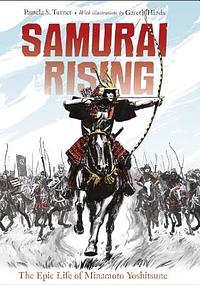Take a photo of a barcode or cover
It can be a bit confusing at times with the similar but different names of various characters. Some background knowledge is helpful but not necessary. Steer towards more capable readers - although it might hook a reluctant reader if this is a topic of interest for them.
The story of Yoshitsune is fascinating, with its feats of daring and the origins of seppuku. I found myself having a hard time keeping everyone straight, but I think that's more from my own personal unfamiliarity with Japanese names and terms than Turner's writing. There's a great list of names in the front, which does help. Turner does an excellent job of explaining traditions that are likely foreign to most students in the United States. My issues with footnotes aside, the bibliography and additional notes in the back of the book are also good. I haven't read any of the starred reviews yet, so I'll have to go do that and see what they saw that I am missing.
My only disappointment was that it didn't include the story of how Yoshitsune and Benkei first met, which is itself such an iconic story. But there were plenty of other asides and tales to satisfy me.
Yoshitsune Minamoto’s life was the stuff of legends, the ideal to which all later samurai would measure themselves. His “inheritance arrived early. They boy could not yet walk when his father left him a lost war, a shattered family, and a bitter enemy.” Sent by his father’s beheader to a Buddhist temple to be raised by monks he eventually escaped north to be taken in by a wealth noble and there trained as a warrior, and commander. Furious, fast and famously brave he specialized in the surprise attack coming down at his enemies from mountain heights and across supposedly impassible bodies of water. Ultimately defeated and fleeing into exile, he fought on to the last, and then committed ritual suicide rather than surrender to his enemies.
Turner’s well documented biography of the iconic samurai presents a wealth of information presented in a lively style accessible to twenty-first century youth. For example, to describe fighting style of the samurai she writes of these medieval oriental knights:
Large scale tactics maneuvers weren’t part of their playbook. In fact, if history’s great fighters were gathered together, Yoshitsune’s men would find a lot more in common with fiercely independent Comanches than disciplined Roman legionnaires.
And as rivals in war sneered and insulted each other before a battle, the author notes, “Trash talk, it seems, is not a modern invention.”






